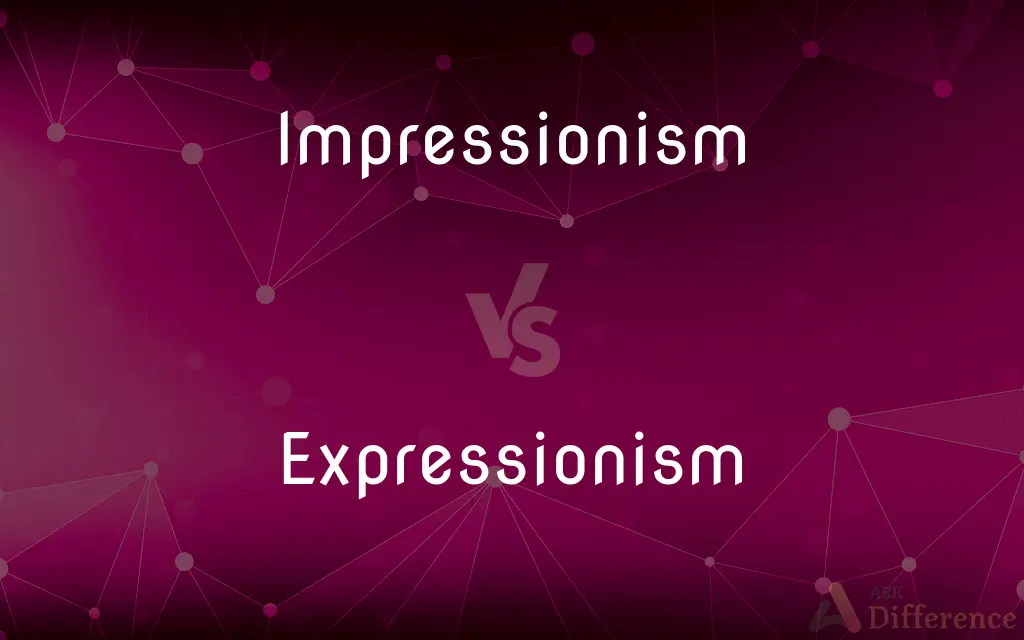Impressionism vs. Expressionism — What's the Difference?
Edited by Tayyaba Rehman — By Urooj Arif — Updated on April 17, 2024
Impressionism captures fleeting effects of light and color, while Expressionism conveys subjective emotions and responses.

Difference Between Impressionism and Expressionism
Table of Contents
ADVERTISEMENT
Key Differences
Impressionism originated in France in the late 19th century, focusing on capturing the momentary effects of light and atmosphere in landscapes and urban scenes. Expressionism, emerging in early 20th century Germany, emphasized emotional experience rather than physical reality.
The technique in Impressionism involves quick, visible brushstrokes that merge to form the final picture only when viewed from a distance. Expressionism utilizes vivid colors and exaggerated forms to evoke moods or ideas.
Impressionists like Claude Monet sought to depict natural scenes under varying conditions of light and weather, often painting the same scene multiple times to capture different moments. Expressionists such as Edvard Munch explored intense personal themes, such as fear and dread, through distorted imagery and stark colors.
While Impressionism often portrays a serene, objective view of the world, Expressionism is typically more turbulent and subjective, aiming to stir the viewer’s emotions and provoke a reaction.
The subject matter of Impressionism is rooted in everyday reality and often features landscapes, street scenes, and figures in candid compositions. In contrast, Expressionism frequently delves into the psyche, with subjects that are abstract, fantastical, or deeply introspective.
ADVERTISEMENT
Comparison Chart
Origin
France, late 19th century
Germany, early 20th century
Focus
Light and atmosphere
Emotional experience
Technique
Quick, visible brushstrokes
Vivid colors, exaggerated forms
Typical Subjects
Landscapes, urban scenes
Emotional, psychological themes
Objective
Capture fleeting moments
Convey subjective emotions
Compare with Definitions
Impressionism
Use of visible brushstrokes to create general shapes.
Impressionism uses brushwork that merges at a viewing distance.
Expressionism
An artistic style aimed at expressing emotional experience rather than physical reality.
Munch’s Expressionism portrays intense emotions.
Impressionism
Artistic focus on scenes of everyday life.
Impressionism frequently depicts bustling city life.
Expressionism
Use of distortion and exaggeration for emotional effect.
Expressionism often features elongated figures and twisted forms.
Impressionism
An approach to capturing the changing qualities of light.
Impressionism explores the shifting play of sunlight and shadow.
Expressionism
A movement characterized by bold colors and dramatic, sometimes grotesque imagery.
Expressionism uses stark contrasts and vivid imagery.
Impressionism
A movement that emphasizes speed and brevity in composition.
Impressionism often involves painting outdoors quickly.
Expressionism
Focus on the artist's subjective perspective.
Expressionism reflects the artist’s personal feelings.
Impressionism
Impressionism is a 19th-century art movement characterized by relatively small, thin, yet visible brush strokes, open composition, emphasis on accurate depiction of light in its changing qualities (often accentuating the effects of the passage of time), ordinary subject matter, inclusion of movement as a crucial element of human perception and experience, and unusual visual angles. Impressionism originated with a group of Paris-based artists whose independent exhibitions brought them to prominence during the 1870s and 1880s.
Expressionism
Exploration of themes like existential angst and despair.
Expressionism often delves into deep psychological turmoil.
Impressionism
Often Impressionism A theory or style of painting originating and developed in France during the 1870s, characterized by concentration on the immediate visual impression produced by a scene and by the use of unmixed primary colors and small strokes to simulate actual reflected light.
Expressionism
Expressionism is a modernist movement, initially in poetry and painting, originating in Northern Europe around the beginning of the 20th century. Its typical trait is to present the world solely from a subjective perspective, distorting it radically for emotional effect in order to evoke moods or ideas.
Impressionism
A literary style characterized by the use of details and mental associations to evoke subjective and sensory impressions rather than the re-creation of objective reality.
Expressionism
A movement in the arts during the early 1900s that emphasized distortion of external reality in order to express the artist's subjective experience.
Impressionism
(Music) A style of art music of the late 1800s and early 1900s, often evoking a dreamy mood and characterized by modal or whole-tone scales, rich and often dissonant harmonies in unconventional progressions, and the avoidance of traditional forms.
Expressionism
A movement in the arts in which the artist did not depict objective reality, but rather a subjective expression of their inner experiences
Impressionism
(arts) a movement in art characterized by visible brush strokes, ordinary subject matters, and an emphasis on light and its changing qualities
Expressionism
A somewhat analogous genre in early 20th century music
Impressionism
(music genre) a style that avoided traditional harmony, and sought to invoke the impressions of the composer
Expressionism
An art movement early in the 20th century; the artist's subjective expression of inner experiences was emphasized.
Impressionism
(poetry) a style that used imagery and symbolism to portray the poet's impressions
Expressionism
A genre of German painting that tried to show the subjective responses to scenes rather than the scenes themselves.
Impressionism
The theory or method of suggesting an effect or impression without elaboration of the details; - a disignation of a recent fashion in painting and etching.
Expressionism
An art movement early in the 20th century; the artist's subjective expression of inner experiences was emphasized; an inner feeling was expressed through a distorted rendition of reality
Impressionism
A school of late 19th century French painters who pictured appearances by strokes of unmixed colors to give the impression of reflected light
Impressionism
A style of painting concerned with the effects of light and color.
Monet’s Impressionism captures the sunlight on the water.
Common Curiosities
How does Expressionism differ in technique from Impressionism?
Expressionism uses exaggerated forms and vivid colors to evoke emotions.
What themes are common in Expressionist art?
Common themes include emotional turmoil, psychological depth, and existential themes.
How did the historical context influence Impressionism and Expressionism?
Impressionism was influenced by the new urban scenes and middle-class leisure activities in late 19th-century France, while Expressionism was a reaction to the anxieties of modern life in early 20th-century Germany.
What role does subjectivity play in Expressionism?
Subjectivity is central, with the art reflecting the inner state of the artist.
What is the main focus of Impressionism?
The main focus is capturing the effects of light and atmosphere.
Can you give an example of a typical Impressionist subject?
A typical subject might be a landscape or a scene from everyday urban life.
What distinguishes the brushwork of Impressionism from Expressionism?
Impressionism features quick, light brushstrokes, whereas Expressionism often has more deliberate, heavy strokes.
Are there specific colors associated with Impressionism?
Impressionists often use natural, softer, pastel shades.
What type of imagery is prevalent in Expressionism?
Imagery in Expressionism is often distorted and vivid to emphasize emotional impact.
How do the goals of Impressionism and Expressionism differ?
Impressionism aims to accurately depict light and its effects, while Expressionism aims to convey emotional experiences.
Share Your Discovery

Previous Comparison
Humidity vs. Moisture
Next Comparison
Sterol vs. SteroidAuthor Spotlight
Written by
Urooj ArifUrooj is a skilled content writer at Ask Difference, known for her exceptional ability to simplify complex topics into engaging and informative content. With a passion for research and a flair for clear, concise writing, she consistently delivers articles that resonate with our diverse audience.
Edited by
Tayyaba RehmanTayyaba Rehman is a distinguished writer, currently serving as a primary contributor to askdifference.com. As a researcher in semantics and etymology, Tayyaba's passion for the complexity of languages and their distinctions has found a perfect home on the platform. Tayyaba delves into the intricacies of language, distinguishing between commonly confused words and phrases, thereby providing clarity for readers worldwide.














































